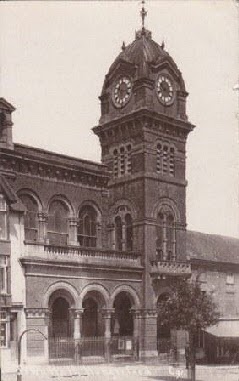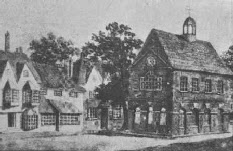I hope you all had a fabulous New Year!
Our resident author, Stuart Miller-Osborne has written a wonderful article about the history of the Town Halls of Hungerford. A great read. Thank you Stuart.
Rita
Imagine this if you will.That in the days leading up to Christmas 1871 a farm labourer (let’s call him George) was slowly walking down the High Street in Hungerford after falling victim to the many inns resident in the town at the time.
George was about opposite the quite recently built Methodist Church when he looked up and to his astonishment, saw two Town Halls.
He turns to his equally inebriated dog, Francis and vows to give up the demon drink as one Town Hall is enough but to see two is just bizarre.
He crosses the road and enters the Methodist Church where he and Francis pray for their sobriety.
If you hop forward some one hundred and forty years, the Hungerford that George and his dog knew is, for the most part, still there. The shops have changed but the buildings are roughly the same and the trains still do not run on time.
But the second Town Hall is long gone and no matter how hard you look, there is no trace of it.
Our magnificent 1871 Town Hall is still there, is well cared for and is accepted as the centrepiece of the town.
It was when I was researching its history that to my astonishment, I found that Hungerford had had at least four Town Halls.
Some thirty years after the report the second “Elizabethan” Town Hall was built in 1573 and lasted until 1786 and like its predecessor, was used for a variety of purposes including commercial activities as well as being sometimes used for billeting soldiers (in the prison cells). Nearby there were other fun items such as Stocks, Ducking Stool as well as a Whipping Post. The first one existed from maybe as early as 1267 and was also known as the Courte House and according to the excellent website on the internet, was most definitely being used in the 14th century. It was used for a variety of purposes but by 1543/4, a survey by The Duchy of Lancaster noted the building as being ruinous and utterly dekeyed .
It appears that during its lifetime it also gained a clock (c1687), the grandfather of current clock which if you consider its position, can be seen from many areas in the town.
I cannot find too much evidence to suggest that this Town Hall decayed that much but it was replaced in turn in 1786 by the third “Georgian” Town Hall of which, incredibly we have a photographic record.
This would have been the Town Hall that George and his dog would have seen if my story was true. This building was a much more substantial affair and stood in the middle of the market place (slightly away from where our present town hall stands) and had an impressive octagonal cupola.
As with the previous building there were prison cells included which became very handy during the Swing Riots of 1831. There was a place for a fire engine although this was later used to enhance the prison cells which suffered from poor sanitary conditions.
With Hungerford Victorians being like other Victorians, it was decided during the 1860s, that a new Town Hall was needed as a bigger Corn Exchange was required. The arrival of the railways had taken away the towns coaching trade and people began to drift away from the town.
The next ten years were quite odd with the 1786 building slowly decaying (and in need of frequent repair). A Mr Hall (The Magistrates Clerk) offered in 1861 to fund half the cost of building a new Town Hall but, his offer was rejected.
However, in the June of 1862 this kind man gave the town a magnificent clock which caused a slight problem. There was nowhere to accommodate it.
 To solve this problem, a new clock tower was proposed and by 1867 the addition was complete. However, like a house of cards, this presented more problems.The new structure was not really satisfactory and it was decided to build a new Town Hall after all.
To solve this problem, a new clock tower was proposed and by 1867 the addition was complete. However, like a house of cards, this presented more problems.The new structure was not really satisfactory and it was decided to build a new Town Hall after all.
The forth “Victorian” Town Hall began life in 1868 when the site was chosen which, if one was looking towards the canal, was to the left of the 1786 Town Hall. Its foundation stone was laid on the 7th of September 1870 and work commenced in full.
By the summer of 1871, the progress on the new building was so advanced that discussions began about the clock which had been given back to the generous Mr Hall.
 It was agreed that two more faces be added and on the 11th of October 1871, the Corn Exchange opened for business with the Town Hall being used for the first time on the 26th of the same month.
It was agreed that two more faces be added and on the 11th of October 1871, the Corn Exchange opened for business with the Town Hall being used for the first time on the 26th of the same month.
As we can see today, the building designed in the Italian Style, was constructed from Bath Stone and red brick. The arches on the front of the building are supported by sturdy stone columns and there is much decoration and ornamentation to be seen.
Even if you sit beneath the arches on the worn stone steps or, on the lovely wooden benches (Do note the one that dates from 1937 and read the interesting inscription) the feeling of the beauty of the building strikes you.
To sit there watching as Hungerford life passes by is amazing and quite relaxing although, the seats can be hard on the backside after a while.
If you look at the Town Hall from across the road (or even from a passing train), it is incredibly handsome and gives Hungerford, which already has some memorable buildings, a real edge from other local towns.
 We are lucky that in the area there are some splendid Town Halls (Newbury and Marlborough to name just two), but our Town Hall sits quietly, not really looking for attention (as the other two do) and this makes it a winner. It is small in stature (in comparison with the others) but I think it is more pleasing, although our neighbours might think differently.
We are lucky that in the area there are some splendid Town Halls (Newbury and Marlborough to name just two), but our Town Hall sits quietly, not really looking for attention (as the other two do) and this makes it a winner. It is small in stature (in comparison with the others) but I think it is more pleasing, although our neighbours might think differently.
Apart from the odd antiques fair and the like, I have not explored the interior of the Town Hall greatly but this, I hope, will be a pleasure for the future. What I do like though, are the occasional charity events which are held near the steps of the Town Hall on certain days.
I like nothing better than walking from the street and looking at the items for sale on the trestle tables. There is something essentially English about this.
But back to more pressing matters, as George and Francis are in the Methodist Church swearing sobriety having witnessed two Town Halls. But was it the local brew that prompted this or, were there two Town Halls?
In short yes there were two Town Halls for a while and the main reason that the previous Town Hall was not demolished at the time was due to the clock being transferred across. So for a while, our fair town had the odd sight of two Town Halls. One almost derelict and one brand new which were both recorded together in the memorable photograph.
 The Methodist Church is still there a little way up the hill (on the same side as Hungerford Arcade) and if you are really feeling silly, walk up the hill and cross the road and look in the direction of the Town Hall and imagine that for a while many, many years ago, there were two Town Halls and although George and Francis are fictitious, this sight might have driven the odd inebriated farm labourer into the arms of the Lord.
The Methodist Church is still there a little way up the hill (on the same side as Hungerford Arcade) and if you are really feeling silly, walk up the hill and cross the road and look in the direction of the Town Hall and imagine that for a while many, many years ago, there were two Town Halls and although George and Francis are fictitious, this sight might have driven the odd inebriated farm labourer into the arms of the Lord.
Stuart Miller-Osborne
For all the latest news, go to our Newsletter at www.hungerfordarcade.co.uk
 To solve this problem, a new clock tower was proposed and by 1867 the addition was complete. However, like a house of cards, this presented more problems.The new structure was not really satisfactory and it was decided to build a new Town Hall after all.
To solve this problem, a new clock tower was proposed and by 1867 the addition was complete. However, like a house of cards, this presented more problems.The new structure was not really satisfactory and it was decided to build a new Town Hall after all. It was agreed that two more faces be added and on the 11th of October 1871, the Corn Exchange opened for business with the Town Hall being used for the first time on the 26th of the same month.
It was agreed that two more faces be added and on the 11th of October 1871, the Corn Exchange opened for business with the Town Hall being used for the first time on the 26th of the same month. We are lucky that in the area there are some splendid Town Halls (Newbury and Marlborough to name just two), but our Town Hall sits quietly, not really looking for attention (as the other two do) and this makes it a winner. It is small in stature (in comparison with the others) but I think it is more pleasing, although our neighbours might think differently.
We are lucky that in the area there are some splendid Town Halls (Newbury and Marlborough to name just two), but our Town Hall sits quietly, not really looking for attention (as the other two do) and this makes it a winner. It is small in stature (in comparison with the others) but I think it is more pleasing, although our neighbours might think differently. 

